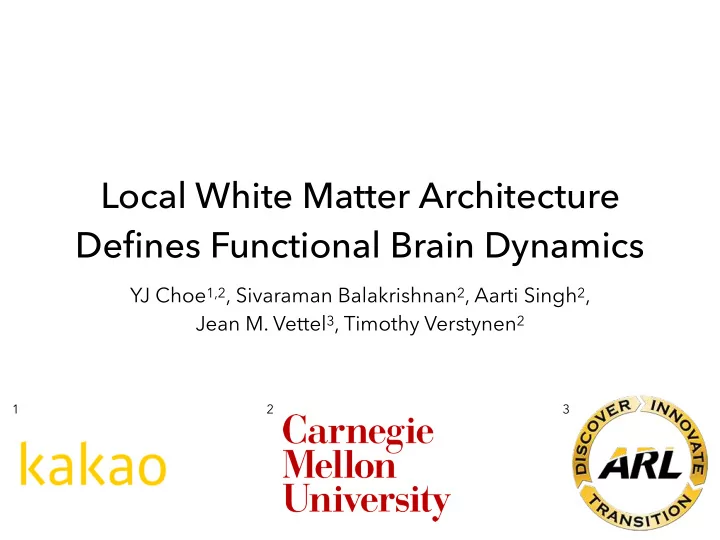

Local White Matter Architecture Defines Functional Brain Dynamics YJ Choe 1,2 , Sivaraman Balakrishnan 2 , Aarti Singh 2 , Jean M. Vettel 3 , Timothy Verstynen 2 1 2 3
The Connectome • Structural connectivity (SC) refers to macroscopic structural linkage, as obtained, for instance, from long- range tracing or diffusion imaging tractography. • Functional connectivity (FC) refers to the statistical dependence between time series describing the neural dynamics at distinct locations in the brain. (Honey et al. 2010) � 2
Is Function Constrained By Structural Capacity? Correlation Between Centrality of Simulated Connectivity Patterns Structural and Functional Networks for Hubbed vs. Random Networks (Honey et al. 2007) (Messé et al. 2015) We are interested in not just (summaries of) the network topology, but about the actual wirings that formulate the connectome! � 3
LCF Measures Local Integrity Along White Matter Bundles Computing a local connectome fingerprint (LCF; Yeh et al. 2016). � 4
FCG Measures Functional Connectivity Patterns Across ROIs A resting-state functional MRI A functional connectivity graph (FCG) (Bhushan et al. 2016, Smith et al. 2013) � 5
Is Functional Connectivity Constrained By The Local Connectome? � 6
The HCP Dataset • We use 793 subjects’ dMRI and resting-state fMRI from the publicly available Human Connectome Project (HCP; Van Essen et al. 2013) dataset. • For each subject, we compute: • A local connectome fingerprint (433,386 features) • A functional connectivity graph (195,625 features) � 7
Hypothesis 1: Similarity in the local connectome between individuals is associated with similarity in their functional connectivity patterns. � 8
Distance-Based Correlations • Because features are high-dimensional, we make use of the distance between these high-dimensional features. • The choice of a distance metric is determined by how effectively the metric identifies unique individual characteristics. � 9
Statistical Inference with Distance-Based Correlations � 10
Similarity in Local Connectome Is Correlated With Similarity in Functional Activity � 11
Hypothesis 2: Variability in specific segments of the local connectome is associated with patterns of functional connectivity in specific circuits. � 12
Canonical Correlation Analysis Local Connectome Fingerprints Functional Connectivity Graphs Linear Projection Linear Projection Projected Canonical Space � 13
CCA in High Dimensions • Classical CCA doesn’t quite work in high dimensions, because (from Gao et al. 2015): 1. The number of features makes each feature difficult to interpret , 2. It is typically impossible to consistently estimate the canonical projections (“alignments”) without additional structural assumptions. ➡ Induce sparsity in learned projections with the L1 penalty! � 14
Cross-Validated Sparse CCA � 15
Canonically Correlated Features Selected by Sparse CCA Structural Features Functional Features � 16
Canonically Correlated LCF & FCG Sub-clusters Association Pathways Ventral Visual Pathways Projection Pathways *Sub-clustering of selected features performed with hierarchical clustering. � 17
Conclusion Variability in the local white matter architecture is associated with global patterns of functional dynamics. 1. A hypothesis test of distance-based correlations showed a statistically significant correlation between similarities of structural and functional connectome. 2. Individual variability in the white matter architecture along major pathways correlates with individual differences in functional dynamics within specific class of brain networks, consistently with existing neuroanatomical knowledge. � 18
Thank You Acknowledgements The research was sponsored by the U.S. Army Research Laboratory, including work under Cooperative Agreement Number W911NF-10-2-0022, and the views espoused are not official policies of the U.S. Government.
Distance Metrics Scaled Euclidean Distance Correlation “Distance” � 20
Structural & Functional Distances � 21
Similarity in Local Connectome Is Correlated With Similarity in Functional Activity � 22
Bootstrap vs. Subsampling � 23
Sparse CCA Classical CCA L1 Penalty � 24
Recommend
More recommend